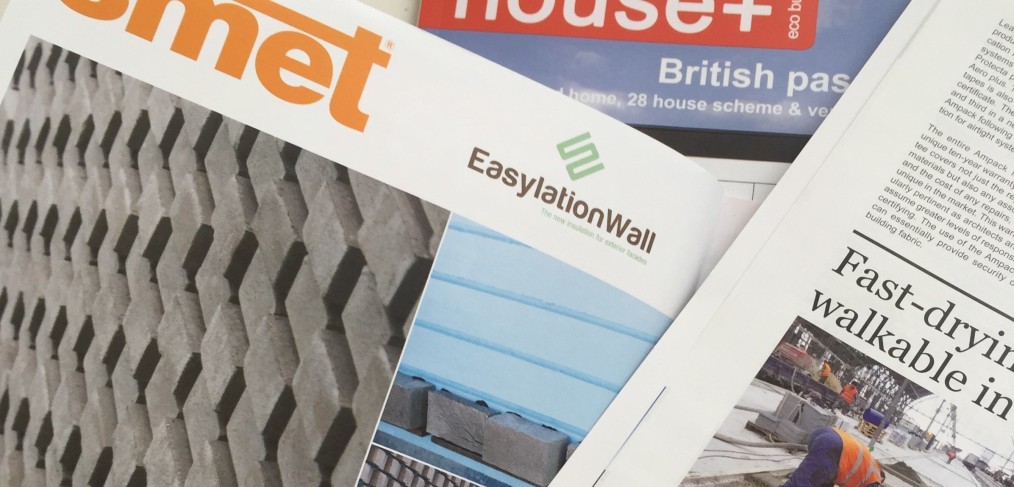
SMET feature in Passive House UK and Ireland editions Feb 16
When time is of the essence… and the floor was needed yesterday… published in Feb16 Passive House Magazine
Joris Smet, Director, Smet Building Products Ltd, highlights the benefits of using Sopro Rapidur® B5 Rapid Drying Screed Binder.
Many new build and renovation flooring projects demand fast turnarounds – from commercial and industrial projects where downtime must be minimised, to the self-builder or renovator, where home-owners simply want their floors completed as quickly as possible, allowing final floor covering.
Traditional screeds require a significant drying before the final floor covering can be installed, however, if this is not well planned for, it may well delay the completion of the entire project.
At SMET, we advise the use of Sopro Rapidur® B5 Rapid Drying Screed Binder, where floor completion is critical. The floor can be walked on in as little as six hours, and floor tiles laid in as little as three days. The key to this product is not only its quick drying capabilities, but the fact that it also develops its full strength quickly, reaching 25 N/mm2 in 24 hours, unlike other quick drying screeds which take the usual 28 days to achieve similar strength.
Made in Germany by our manufacturing partners, Sopro Rapidur® B5 Rapid Drying Screed Binder makes a lovely workable screed. It’s also got that all-important long open-time and it finishes beautifully. Applicators tell us time and again how malleable it is compared to other regular rapid drying screed binders. It’s really got it all – being a special polymer-modified binder specifically for use in rapid-set cement screeds, it allows early flooring installation to DIN 18 560 and BS 8204-1, and uniquely, it is particularly suitable for use with UFH. The screed is easily laid to falls, and – the holy grail of rapid drying screeds – it’s pumpable.
FAST-TRACK
Sopro Rapidur® B5 Rapid Drying Screed Binder is suitable for use on heated screeds, bonded screeds, unbonded screeds, screeds laid on insulation layer and for floating screeds. Trained Smet Supported Partners site-mix the Rapidur® B5 binder with 0–8mm gravel sand, producing particularly economical high-strength, rapid-set cement screeds. It’s also suitable for producing grade CT-C60-F7 cement screeds to BS EN 13813 and, depending on aggregate quality and mixing ratio (sand/ Rapidur® B5/water), higher-grade screeds can also be produced.
Placed screeds incorporating Sopro Rapidur® B5 are ready for tiling after approximately three days and ready to receive natural stone finish after around five days. The maximum moisture content of ≤ CM 2.0 % must be confirmed by a required CM moisture measurement prior to flooring installation. Particularly impervious floor coverings, such as linoleum, PVC etc should be laid at the earliest after five days or after achievement of moisture content ≤ 2.0% CM (for unheated screeds) /≤ 1.8% CM (for heated screeds).
TRIED AND TESTED
Rapidur® B5 has been regularly used in Ireland and the UK for prestigious jobs where the repair, renovation and tight turn-around of the floor is paramount. In production facilities, such as Cadbury‘s factory in Dublin and Batchelor’s Factory in Dublin, the quick-drying action of Rapidur® B5 minimised the time the area was out of action, thus making it quicker to resume production, warehousing and using valuable industrial space. In the hospital environment, St James’ Hospital, Our Lady of Lourdes and Letterkenny Hospital benefited from the new floor’s early high-strength and rapid drying capabilities. Queens University Belfast‘s new School of Law extension is currently gaining momentum with the use of B5 smoothing out the extensive floor in this large renovation. Public buildings such as the Soloist in Belfast, community centres and local historical buildings have also benefited vastly from Rapidur® B5 fast-track flooring installation under tight schedules. Indeed, if your project is in a supreme hurry, SMET BINDERhas a further fast-track flooring solution available, where tiling is possible even after just 24 hours, and walkable after three.
Developed by Sopro in one of Germany’s most advanced industrial chemical laboratories, Rapidur® B5 has been used in many high profile projects in Germany and further afield. One such recent project was the extensive renovation measures carried out at Frankfurt Central Station. This included the repair and regeneration of 6,000m² of public platforms. The challenge here was restoration, while still operating the trains and keeping access to public open at all times. The contractor had only days to complete the sections; however, by using the complete fast track flooring system from Sopro Bauchemie – from the floor to the grouts – with all products capable of rapid strength development, rapid drying and high compressive strength – the demands of the project were fully met. Again, the key drivers for selection of Rapidur® B5 are the long open time (the mortar is workable for a maximum of two hours); plus, the speed of early very high strength (up to CT-C60-F7) development and its suitability for through-ways with high and early traffic loads.
Benefits of Sopro Rapidur® B5
- Ready to receive floor covering: after approximately three days for subsequent tiling, after achievement of moisture content ≤ 1.8 % CM for particularly impervious floor coverings, eg linoleum, PVC etc. and wood or parquet flooring.
- For indoor and outdoor use.
- Working life: approximately two hours.
- Walkable: after six to ten hours.
- Suitable for floor heating systems (UFH).
- Pumpable.
- Good workability.
- Tested to CT-C60-F7 DIN EN 13813.
- CT-C25-F4 after one day; CT-C40-F6 after three days; CT-C50-F7 after five days; CT-C60-F7 after 28 days*
- Low-chromate to Regulation 1907/2006/ EC, Annex XVII.
For more information on Smet Building Products Ltd telephone 028 3082 5970 or visit www.smetbuildingproducts.com or www.smet.ie
* Values are for mixing ratio of 1: 4 or 25 kg Sopro Rapidur® B5: 100 kg (0–8 mm) screed sand and 10 ltr water (available test certificate to DIN EN 13813 issued by Technische Universität München).
